Sapphires, rubies and emeralds are three of the most coveted, valuable, beautiful, and rare gemstones in the world. Having various rings and jewelry with sapphires, rubies, and emeralds would be nothing short of amazing, but what if you could only choose one? Would you pick a sapphire, ruby or emerald?
SAPPHIRE VS RUBY VS EMERALD
Need help deciding between a sapphire, ruby or emerald? We have matched up the Big Three Gemstones based on the following categories:
- General Info (What kind of mineral is it?)
- Origin
- Color
- Harness & Durability
- Clarity
- Treatment
- Rarity
- Value
- History, Lore & Symbolism
Hopefully this comparison will help you make a decision on which precious gemstone is right for you…

GENERAL
Sapphire: A sapphire is a variety of the mineral corundum. It consists of aluminum oxide as well as other trace elements, such as iron, titanium, chromium, vanadium or magnesium. These trace elements within the aluminum oxide are what give a sapphire its color. While typically blue, a sapphire can be yellow, purple, orange, green or white depending on the various elements and how much it contains (for example, just a hundredth of a percent of iron and titanium will make it blue, and the more iron it has, the darker blue it will be).
Ruby: A ruby is actually the same exact type of mineral as a sapphire, except it is red. When a mineral corundum is red, it is classified as a ruby. It is the only color of corundum that is not called a sapphire. So, essentially, a ruby is a red sapphire (or red corundum). A ruby gets its color from chromium, as do purple sapphires. However, with red corundum, more chromium is present, giving it that dark pinkish to blood-red color.
Emerald: Emeralds are a variety of the mineral beryl. It gets its beautiful color from trace elements of chromium and/or vanadium. Unlike sapphires, emeralds will always be green, but the vividness and intensity vary.

ORIGIN
Sapphire: All natural sapphires are incredibly old. They formed deep in the Earth’s crust over 150 millions years ago due to certain shifts in heat and pressure. What’s more, sapphires don’t just develop in any rock, they crystalize in slow cooling igneous or metamorphic rocks that are rich in aluminum and devoid of silicon (note: silicon is one of the most common elements in the crust of the earth, which is part of the reason why they are so rare). Deposits, which can be found around the world, such as Tanzania, Madagascar, Sri Lanka, Myanmar, and Montana, supply rocks (granite, schist, gneiss, nepheline, and more) that contain sapphires.
Ruby: As rubies are also corundums, everything above applies. The only thing we can add is that the bulk of the world’s supply of rubies are found in South East Asia – i.e. Myanmar, Sri Lanka, Cambodia, Thailand, and Afghanistan.
Emerald: Beryl forms in hexagonal crystal in hydrothermal veins or magmatic pegmatites in the earth. It requires the right temperatures and space, and beryllium, aluminum, silicon and oxygen must be present. However, that is just for beryl. To be an emerald, the beryl must be green. Beryl is actually colorless if pure. So, to become green, there needs to be trace elements of chromium and vanadium where the beryl grows. As with sapphires, this all occurs over hundreds of thousands (and likely many, many more) years. And in regard to where they are found, like sapphires, emeralds are mined all over the world. Yet, much of the world’s supply comes from Colombia, Brazil and Zambia.
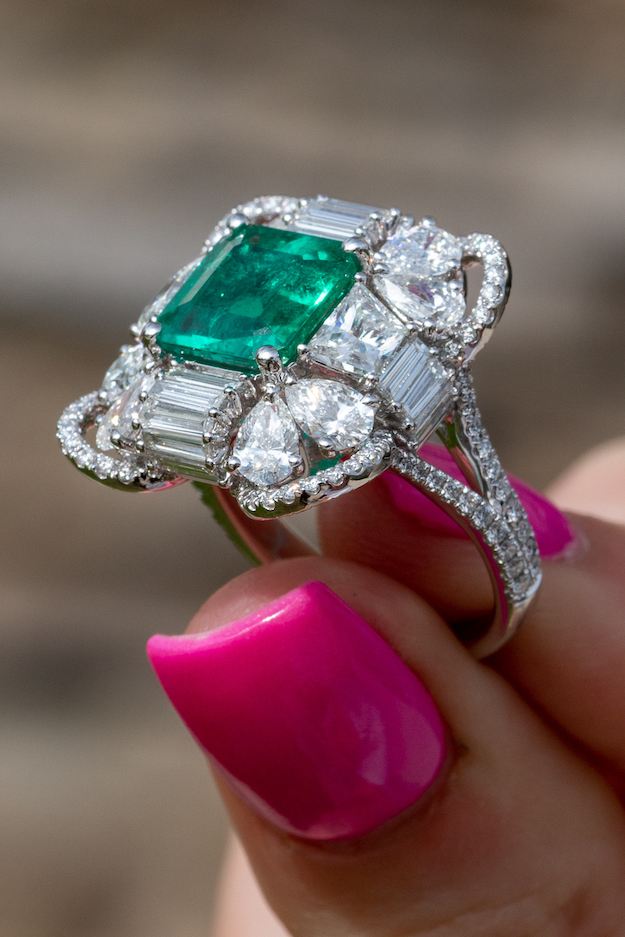
COLOR
Sapphire: Although the most popular and typical sapphire color is blue, sapphires occur in a wide range of colors. They can be colorless, pink, orange, yellow, black, purple and everything in-between. By “in-between”, we mean that depending on the trace elements, the sapphire can have a unique overtone and hue, such as purplish-pink, orangish-pink, greenish-blue and so on. The most sought after and valuable colors are pure velvety blue (i.e. Kashmir blue sapphires) and orange-pink (a sapphire with a rare mix of orange and pink is called a Padparadscha sapphire). All that said, any sapphire with a rich color will be highly desirable and valuable, as everyone has their own preference. So, generally speaking, regardless of the specific color, the richer and more vibrant the sapphire’s color, the more valuable it will be.
Ruby: While rubies are red in the most general sense, the precise color of rubies can vary from blood-red (the most valuable) to orange-red, purple-red, pink-red and brown-red. As long as the primary hue is red, it will be classified as a ruby. However, this can be difficult for a non-expert eye to determine if it is close (a GIA certificate will tell you what you need to know). All in all, the finest quality rubies will be neither too dark nor too light, with vibrant red and slightly purplish-red being the top choices.
Emerald: Emeralds come in hues ranging from yellowish-green to bluish-green, with the primary hue always being green. In regards to tone, an emerald must have a medium to dark tone or else it is actually a green beryl, not an emerald. Overall, the most desirable emeralds are bluish-green to pure-green, with vivid color saturation and tone that is medium or not too dark.
Note: Sapphires and rubies both use a grading system ranking from Natural AAA to Natural B (AAA, AA, A, B), with AAA being the rarest and most expensive, accounting for just 1% of all natural corundums.

HARDNESS & DURABILITY
Sapphire: Sapphires have a 9 out of 10 on the Mohs Hardness Scale. They are the third hardest mineral that exists. Only diamonds and moissanite are harder. This means sapphire rings are extremely durable and perfect for everyday wear. Unlike many semi-precious gemstones, you don’t have to worry about breaking or damaging a sapphire.
Ruby: As rubies and sapphires are the same mineral, the exact points above apply to rubies.
Emerald: Emeralds have a 7.5-8 on the Mohs Hardness Scale. For reference a steel file is a 6.5. The point is, emeralds, while not as hard and durable as sapphires, are very resilient. They are perfect for everyday wear too. They are very scratch resistant and durable, so it would be very unlikely that you damage an emerald ring, for example.
Note: Diamonds are 90 times harder than sapphires! Nevertheless, part of the reasons sapphires, rubies, and emeralds are so valuable and desirable, besides beauty and rarity, is their durability.
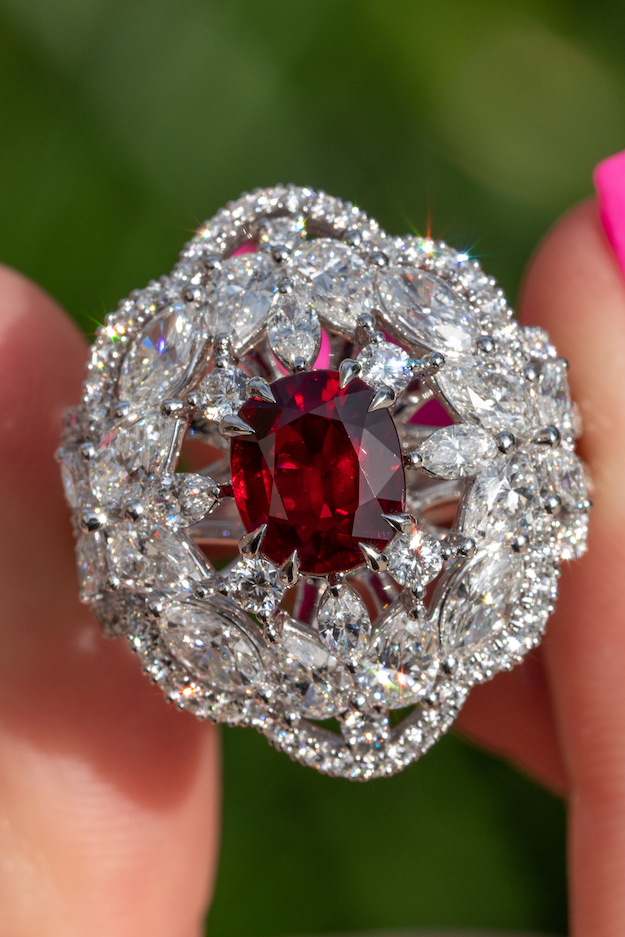
CLARITY
Sapphire: The vast, vast majority of natural sapphires have inclusions, even if it isn’t visible to the naked eye. If there are no inclusions (under a magnifying loupe), then it is likely a lab-created sapphire. Overall, the fewer inclusions, the rarer the sapphire. As for grading, it goes Type 1, Type 2 and Type 3, with Type 1 having no inclusions visible to the naked eye. Type 1 sapphires are obviously the most valuable.
Ruby: Inclusions and flaws are extremely common for rubies too. Rubies use a clarity grading system similar to diamonds, which is VVS, SI1, SI2, I1, I2, I3. VVS means very very slightly included, and SI means slightly included, and I being obviously and prominently included. As inclusions are completely normal and not the biggest factor when pricing a ruby, particularly for jewelry, the best thing you can do is avoid highly noticeable inclusions, especially chips, cavity imperfections, feather flaws and crystal inclusions. It’s best to stay in the VVS to SI2 range.
Emerald: Like sapphires and rubies, emeralds have inclusions, which include small amounts of gasses, minerals, crystals and liquids that occur during the crystallization process. With emeralds, they are unavoidable, as 99% of natural emeralds have inclusions visible to the naked eye. Although emeralds use the same Type 1-Type 3 grading system as sapphires, even Type 1s can have inclusions visible to the naked eye. So, when buying an emerald or emerald rings, just avoid emeralds with too many inclusions and very prominent inclusions, because that will affect both the beauty and durability of the stone.
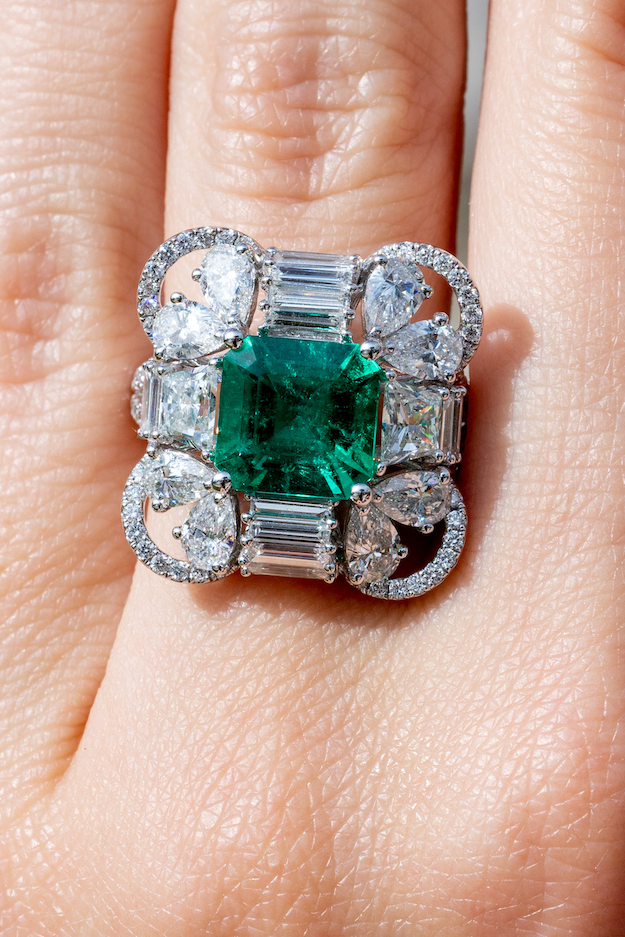
TREATMENT
Sapphire: The vast majority of sapphires in the jewelry marketplace have underwent heat treatment. Heat treatment improves the sapphires color, removes color zoning, and improves clarity. It is usually done for lower color quality sapphires, to make them jewelry worthy. Needless to say, natural sapphires that are untreated are rare and much more valuable, even if they have inclusions.
Ruby: Like sapphires, non-gem quality rubies are more common, so treatment is done to turn them into “gem-worthy”, specifically for jewelry. Heat treatment is the most common for rubies too. It improves color, removes purple tinges, blue patches and silk. If a ruby has heat treatment, the price will reflect. Of course, high quality untreated rubies can command a very large premium.
Emerald: Because emeralds are among the most included of all gemstones, inclusions are tolerated even in the finest emeralds. However, many emeralds have very noticeable inclusions like internal gas bubbles, cracks and embedded crystal that affect both durability and beauty, and they must undergo treatment. The most common treatment for emeralds is fracture-filling, where oils fill these inclusions using heat and pressure. That said, they can be enhanced to a greater or lesser degree. So, gemological reports should indicate how much enhancement was done. It can range from none to insignificant, minor, moderate, and significant.
Note: Around 1-2% of sapphires, rubies and emeralds are untreated. So, if you want a gemstone that is truly rare, stunningly beautiful and valuable in every sense, go for an untreated stone. But if you are looking to save money and still have a beautiful piece of gemstone jewelry, it’s ok to go with a gemstone that has heat treatment. Just understand it will not be a truly “precious gemstone”.
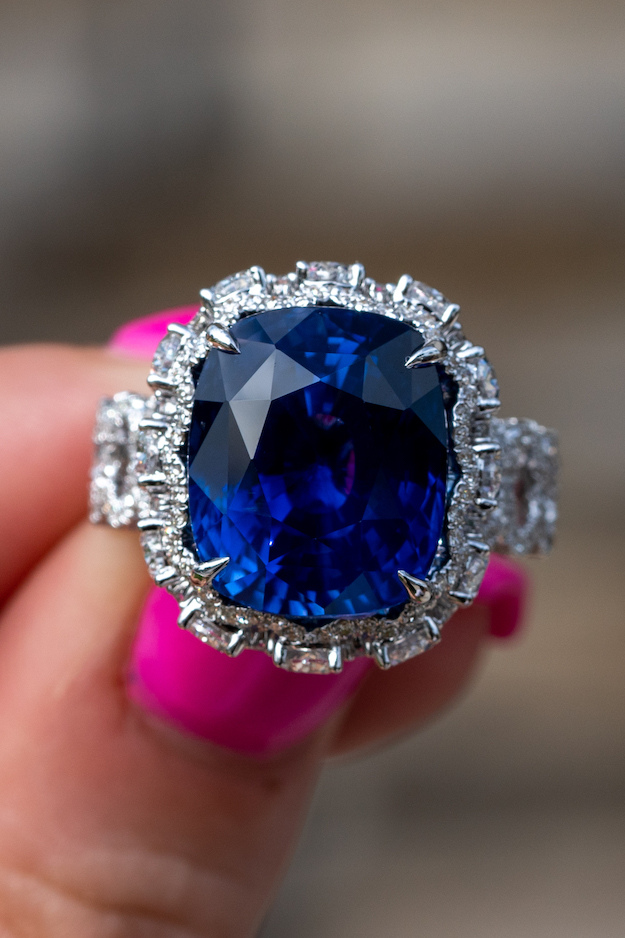
18kw blue sapphire and diamond pave cocktail ring. Cushion Sapphire of14.73ctw – intense to vivid blue – Natural Sapphire (no heat) Origin: Sri Lanka – Contact us for pricing
RARITY
Sapphire: Gem-quality untreated sapphires are extremely rare, especially Padparadscha sapphires and Kashmir velvety blue sapphires (Padparadscha sapphires are the rarest). In fact, they are among the rarest colored stone in the world.
Ruby: Untreated natural rubies are extremely rare. They are actually significantly rarer than sapphires, which is why they are even more expensive.
Emerald: Like sapphires and rubies, emeralds are among the rarest of all gemstones. They are rarer than sapphires but not quite as rare as rubies.
Note: Comparing to diamonds, fine quality sapphires, rubies and emeralds are far, FAR more rare.
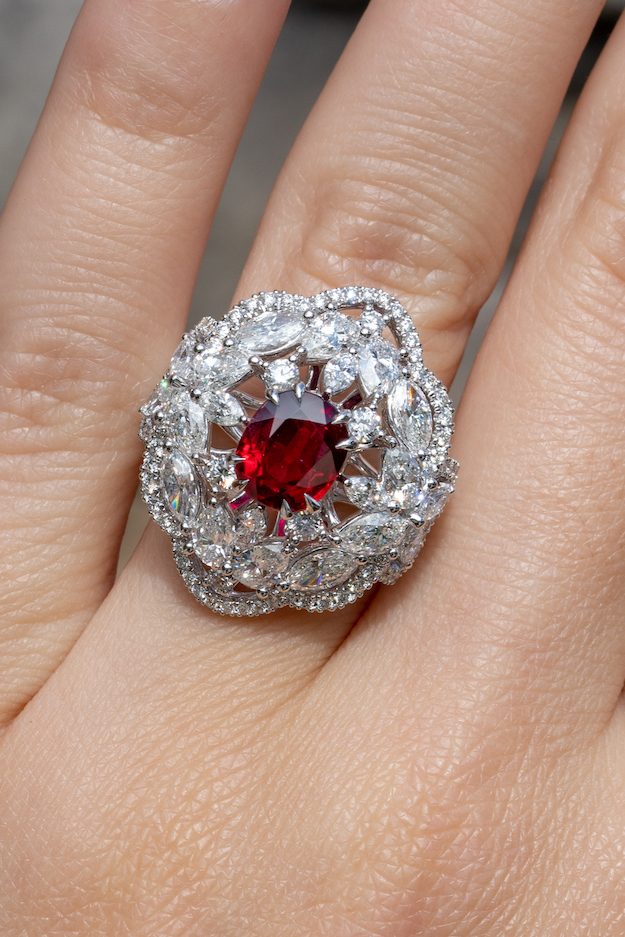
18kw oval ruby center and multi shape diamong wide cocktail dome ring – Oval ruby of 2.53ctw, 1 stone – Natural Ruby Vivid red (no heat) Origin: Mozambique – Contact us for pricing
VALUE
Sapphire: Blue sapphires and pink sapphires are the most valuable. Most sapphires range from $500 to $2,000 per carat, depending on quality. However, very fine quality sapphires can be $11,000 per carat or more. Padparadscha sapphires are typically priced from $6,000 to $12,500 per carat. The record for a sapphire sold at auction goes to a Kashmir sapphire that sold for $242,000 per carat.
Ruby: Rubies are one of the most expensive gemstones in the world, with record prices over $1 million dollars per carat. That said, generally speaking, a fine quality ruby will range from $5,000 to $15,000 per carat.
Emerald: Good quality emeralds sell for similar prices as sapphires. However, larger carat sizes are usually more valuable in comparison. For example, a 5 carat emerald can sell for between $7,500 to $15,000 per carat, which is on par with ruby prices. The record for an emerald sold was around $300,000 per carat.
Note: It is almost impossible to give a general price for sapphires, rubies or emeralds as so many factors (color, clarity, carat weight, cut, and treatment) come into play. But generally speaking, it goes ruby, emerald and sapphire for most to least expensive. Nevertheless, it is relatively close and all three are extremely valuable if they are natural, fine quality, and untreated.
Sapphires, Rubies and Emeralds have all been outpacing the price of diamonds over the last couple decades. They are extremely popular.
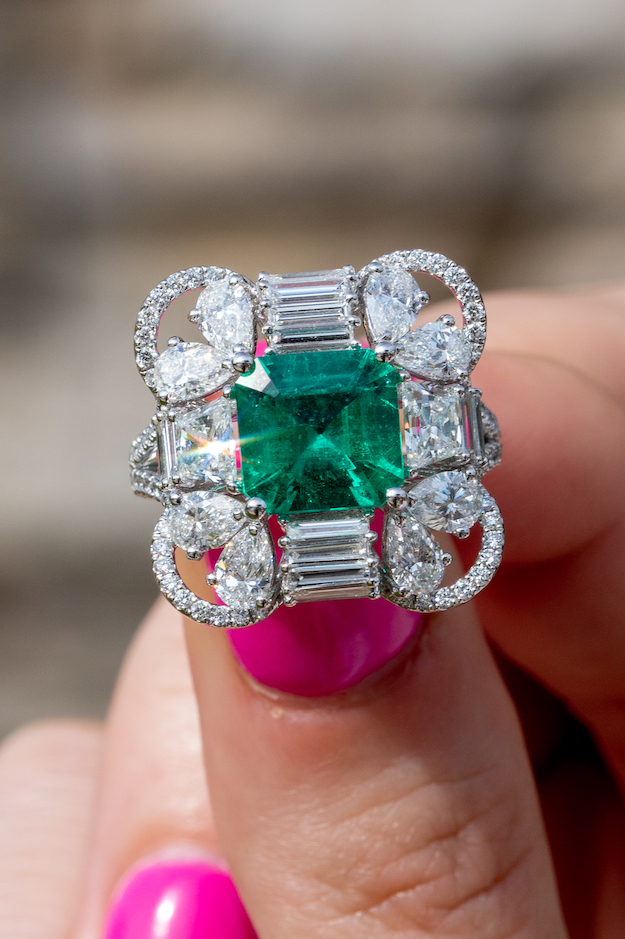
18kw emerald center and multi shape diamond cocktail wide ring – Emerald of 2.55ctw, 1 stone GRS2018-058493 Natural Emerald (non-enhanced, fissure is eye visible) Origin: Colombia – Contact us for pricing
HISTORY, SYMBOLISM & LORE
Sapphire: Since they were first discovered many, many centuries ago, sapphires have been among the most desirable of all gemstones.There has always been a strong lore when it comes to sapphires. In Ancient Greece and Rome, kings and queens believed sapphires would protect them from envy and harm. During the Middle Ages, wealthy clergy wore sapphires to symbolize heaven and attract blessings. In other places and times, people were convinced sapphires had the power to make peace, influence spirts and reveal the secrets of oracles. Today, sapphires are associated with royalty and romance. They symbolize nobility, truth, sincerity and faithfulness.
Ruby: The ruby has always been the king of gemstones. Like sapphires, they were even mentioned in the bible and have been worn by royalty throughout human history. Rubies were believed to protect warriors during battle and provide health for the holder. They have a powerful association with vitality, health, love, and power. Hold a rare natural ruby in your hand and you will feel an undeniable sense of vigor.
Emerald: Reports of the first emerald mines date back to 330 BC in Egypt. Ever since then, they have soothed souls and excited imaginations. Royalty have always had a strong affinity towards emeralds. Cleopatra is probably the most notable as she had an incredibly strong passion for emeralds. As for legends, like sapphires and rubies, they are plentiful. Emeralds were believed to cure diseases, reveal truth or falseness of a lover’s oath, and even make the wearer more witty and an eloquent speaker. To this day, spiritualist deeply covet emeralds for their mystical properties. For the average person, emeralds are said to represent growth, reflection, peace and balance. Moreover, they promote health and fertility, which is a belief that dates back hundreds of years.
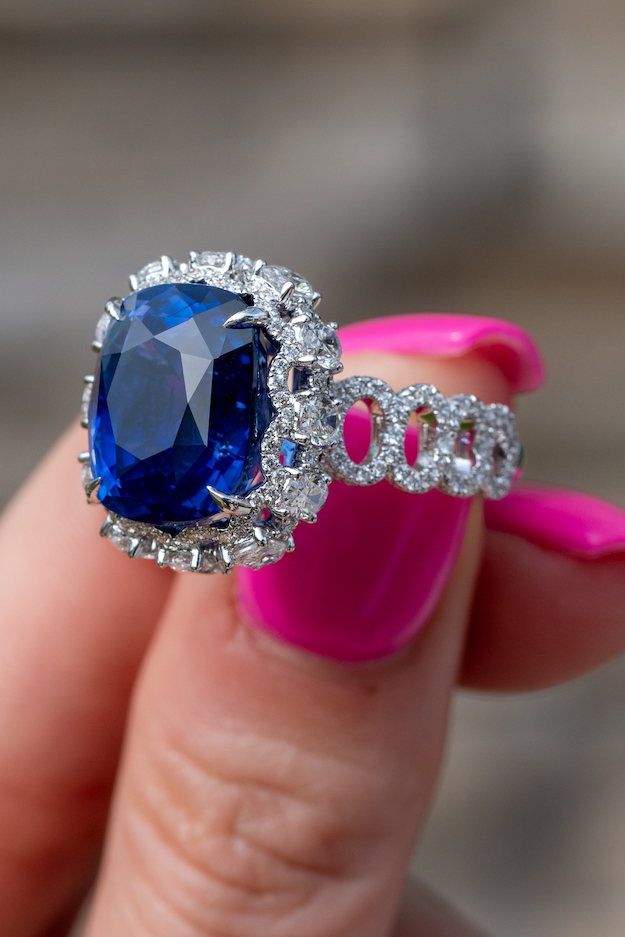
FINAL VERDICT – SAPPHIRE, RUBY OR EMERALD
Choosing between a sapphire, ruby or emerald can be quite difficult as all three are extremely attractive, rare, and valuable. But, it really just comes down to personal preference, especially in terms of color. In an ideal world, you could have various kinds of rings and jewelry with sapphires, rubies and emeralds, as all three are must-haves for those with the wherewithal.
If you can only pick one for now. Choose one the one that speaks to you the most. We hope the information above helps you in your decision. In any case, you really can’t go wrong with a sapphire, ruby or emerald.
Shop Sapphire, Ruby and Emerald Precious Gemstones at Diamonds By Raymond Lee:
Sapphire Jewelry
Ruby Jewelry
Emerald Jewelry
Ten articles before and after
How To Get a Custom Diamond Engagement Ring From Designer Brands
Round vs Oval Diamond, Which is the Right Choice For You?
Review of the Panerai Submersible Carbotech PAM960 Dive Watch
7 Unique Natural Gemstone Rings at Diamonds By Raymond Lee
Top 5 Luxury Watch Brands & Why They Are The Best
5 Reasons Why Richard Mille Watches Are So Expensive
Romantic Valentine's Day Jewelry For As Low As $299
Historical Review of the Panerai Luminor Marina PAM 104
Hot Review: Limited Edition Richard Mille RM 011 "Black Phantom" Watch
In-depth Review of the Tudor Heritage Black Bay GMT "Pepsi" Watch

